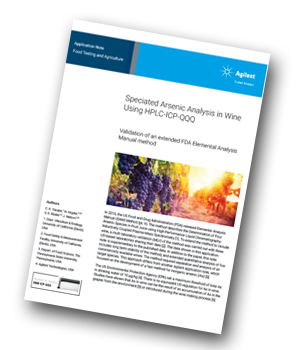Agilent Technologies has produced an application note presenting validation data supporting extension of the FDA Elemental Analysis Method (EAM) §4.10 to include wine. This method currently describes the determination of four arsenic species in fruit juice using High-Performance Liquid Chromatography-Inductively Coupled Plasma-Mass Spectrometry (HPLC-ICP-MS).
 Introduction
Introduction
The US Environmental Protection Agency (EPA) set a maximum threshold of total As in drinking water of 10 μg/kg. There is no equivalent US regulation for As in wine. Studies have shown that As in wine can be the result of an accumulation of As in the grapes from the environment or introduced during the wine making process.
The inorganic forms of As (iAs) are the most carcinogenic and, as a result, the FDA established an action limit for iAs in apple juice of 10 μg/kg in 2013. FDA EAM Method §4.10 details a relatively simple and robust method for the determination of As species in fruit juice using HPLC-ICP-MS. Due to recent media attention on As levels in wine, and the lack of published research on As speciation in wine, extension of EAM §4.10 to include wine is a logical next step.
In this study, EAM §4.10 was modified for the determination of the main organic arsenic species (DMA and MMA) and the more toxic inorganic forms (As(V) and As(III)) in wine using HPLC coupled to a triple quadrupole ICP-MS (ICP-QQQ).
Instrumentation
An Agilent 1260 Infinity LC comprising a binary pump, autosampler, and vacuum degasser was coupled to an Agilent 8800 Triple Quadrupole ICP-MS (ICP-QQQ).
Results and Discussion
Method blanks (3% ethanol) spiked with low levels of As(III), DMA, MMA, and As(V) were prepared and analyzed for the determination of the detection limits. The limits of detection (LOD) for the As species in wine were calculated as described in the FDA’s Elemental Analysis Manual Section 3.2. The limits of quantification (LOQ) for each species were calculated as LOQ = Dilution Factor (DF) x 30 x σ. The LOQs for As(III) and As(V) were 1.18 and 1.35 μg/kg, respectively. The LOQ for total inorganic arsenic (calculated from the SD of the sum of the integrated peak areas for As(III) and As(V) in each repeat of the low standard) was 2.53 μg/kg.
Conclusions
The As speciation results obtained using an Agilent 1260 Infinity LC coupled to an Agilent 8800 ICP-QQQ were used as part of a multi-laboratory validation (MLV) to validate the extension of Elemental Analysis Manual Method §4.10 to include wine. The method was optimized for the analysis of four arsenic species including the toxicologically relevant inorganic forms, As(III) and As(V).
In addition to the data published as part of the MLV, five more wines were analyzed. The total As levels of the five wines were between 8.56 and 26.19 μg/L. These levels are below the Canadian and European regulatory limits for total As in wine of 100 and 200 μg/kg, respectively. The average percentage of As found in the form of iAs in the five wine samples was 95%.




